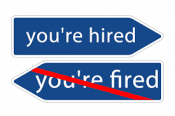 The transition was especially hard for me as I didn’t see it coming. My numbers were good, my boss was happy, my peers were friendly. Everything was going great, except for one thing – fit. The experts will tell you it’s all about fit, and it is. But fit is a complex concept. Not only must your skills meet the needs of the company, but your hopes and aspirations must fit in with those of the people around you. That was my problem. Apparently, I didn’t fit.
The transition was especially hard for me as I didn’t see it coming. My numbers were good, my boss was happy, my peers were friendly. Everything was going great, except for one thing – fit. The experts will tell you it’s all about fit, and it is. But fit is a complex concept. Not only must your skills meet the needs of the company, but your hopes and aspirations must fit in with those of the people around you. That was my problem. Apparently, I didn’t fit.
My adventure began when my transition coach walked into my office. It ended fifteen months later when we celebrated my new job over lunch.
Being fired just before Christmas was not my idea of good timing. I was simultaneously in a state of shock, denial, embarrassment, and paranoia. I was basically frozen in the headlights for a month until I could gain momentum. But in January, I gathered myself together and made the trips to the outplacement agency office. Having  been exposed to the job search process once before, I knew I could be in for a lengthy journey. My coach advised me that my next job would probably come from my “network” and that I had better get busy and build one. He advised me that the best way to build a network was with “one-on-one” meetings. He said that my search would take about a year and that I would have to meet about 150 people.
been exposed to the job search process once before, I knew I could be in for a lengthy journey. My coach advised me that my next job would probably come from my “network” and that I had better get busy and build one. He advised me that the best way to build a network was with “one-on-one” meetings. He said that my search would take about a year and that I would have to meet about 150 people.
Throughout the process I developed a tremendous fear that a year would come and go, and I would still not have a job. I realized that, as an executive with an industrial background, many of the jobs I was suited for were going offshore. So, I decided to build myself a transition plan that, if anything, was on the aggressive side. I planned to be out for up to two years and set a target of 250 meetings. I also decided that, if I was out for two years, I wanted to be able to look back and say that I had done my best.
The first part of my plan was to network with friends, associates and recruiters. I built a PowerPoint slide that I called my “strategic map” for my network meetings. It showed in block diagram form, my career history, my list of target companies, and my target roles. I used this instead of my résumé at every networking meeting. It was  a big success as my contacts seemed very happy that they could look at this simple document and didn’t have to read my résumé.
a big success as my contacts seemed very happy that they could look at this simple document and didn’t have to read my résumé.
I then called all the recruiters and set up as many meetings as I could. I ended up seeing all the majors and about fifteen minors along the way. Some people say that the recruiters are a difficult bunch, but I found that if you are open and honest with them, they will be the same way with you. And I always had to remind myself that a good network connection can sometimes take a year or more to evolve, so I had better have a long-term plan. So, in my recruiter meetings, I tried to find out their interests and to be a part of their lives. That meant that I joined some new associations, attended numerous lunch and breakfast seminars and gave away a few event tickets. But slowly my relationships built. I determined that it would be up to me to continue with these relationships because, if they weren’t building them with me, they were building them with someone else.
The Magic of Networking
I never entered into a network meeting expecting to find a job. The objective of the meetings was to get between two and five names of other executive contacts and always to help the individual I was meeting as much as possible. I set a target to average one meeting per day for as long as I was out. In retrospect, setting a “meeting target” was the best thing I could have done. I tracked this on my calendar and had the cumulative total always stuck to the top of my computer screen. Quite often during the search process, I would become despondent and disoriented. But I knew that if I could keep meeting new people at a rate of twenty per month, that I was  making progress.
making progress.
The first two months were focused on recruiters and friends in an attempt to build my list of names. At first, I wasn’t much help to anybody. But over time, as my network began to build, I surprised myself how much information I had collected, and that I could dispense at a moment’s notice. The first contact meetings were open ended. That is to say there would be little overlap between the contact’s network and my network, so I had little to offer these new contacts. However, at about four months things began to change. At this point, I had met all the recruiters, joined three associations and had met about fifty new people. Now, at least, I had something to talk about. Among other things, I joined the Institute of Corporate Directors, the Toronto Venture Group, and the Canadian Manufacturers and Exporters Association where I sat on their energy committee. This gave me a broad list of contacts and now I had much more to contribute in my networking meetings.
At about nine months (one hundred and fifty meetings), my network had grown to the point where I was confident that I could contribute in almost any meeting. At this point, I usually knew someone in common, or someone who could help them. In fact, in some cases, I was beginning to gather seemingly random and independent  facts that, when put together, could be quite powerful. I found out industry trends, competitive information and even a little inside information. I found out, that as a full-time networker, I had an advantage over my contacts who had a full-time job. I had information. The contacts began to look forward to follow-up meetings, instead of dreading them. I was finally able to help.
facts that, when put together, could be quite powerful. I found out industry trends, competitive information and even a little inside information. I found out, that as a full-time networker, I had an advantage over my contacts who had a full-time job. I had information. The contacts began to look forward to follow-up meetings, instead of dreading them. I was finally able to help.
Early on I was told that my next job would come from my network. I found that in today’s world, that is changing slightly as most senior executive positions were tending to come through the recruiters so that the originating company can appear to be completely independent and unbiased. But that is not exactly what happens. Because of the hundreds and thousands of names that come over the Internet and other sources, recruiters use their networks as a filter. They tend to look to their network for a few key individuals, instead of the Internet for a few hundred. So, it is important to build relationships and stay “top of mind”. (On a couple of occasions, I went through the interview process only to find out that the decision was already predetermined. In the processes where I was most successful, I was the one who networked in before hand.)
Read More: Online Recruiting Magic (Or So Some Would Have You Believe)
Attitude and Commitment
In the transition process, there were many things that were out of my control. But two things I knew I could control were my attitude and my commitment. My job during transition was to build a plan, stick to it, and be positive. One of the best ways I found to stay positive was through the execution of my networking plan. I found networking to be a very enriching and energizing activity.
Some days during the transition process I would be labouriously going over my lists and making my calls. Then, at some point, I would finally make a direct contact, set up a meeting and everything would change. I immediately became more upbeat, positive, and energized. I would begin looking up more information on the individual  and his industry, and a new adventure would begin. I would look for ways I could contribute to the meeting and help the individual with my contacts. As I gained experience in the process this became very successful. Many of our contacts would overlap and I could help. I could provide names of other contacts, associations or interesting web sites. I could provide information on industry trends or changes that I had noticed. Or, in some cases, I could actually provide competitive information. I became re-energized.
and his industry, and a new adventure would begin. I would look for ways I could contribute to the meeting and help the individual with my contacts. As I gained experience in the process this became very successful. Many of our contacts would overlap and I could help. I could provide names of other contacts, associations or interesting web sites. I could provide information on industry trends or changes that I had noticed. Or, in some cases, I could actually provide competitive information. I became re-energized.
Strangely, I also noticed that my “perceived value” seemed to go up as my transition experiences built. In fact, it appeared to me that, over time, people began to evaluate me based upon what I had accomplished during my transition phase, more than some of the achievements on my résumé. They seemed to treat my transition as if it were my most recent job. I think, subconsciously, people came to believe that how I conducted myself during the transition period would be a good predictor of how I would do on a new job. And I think they are right. I found that one of the ways I could differentiate myself from the other job seekers was to have an active transition period, continue to build momentum, and then talk about it with my network. And as my coach always reminded me, “momentum builds momentum”. So, over the period, I continued to escalate my activities.
Read More: The Big Three In Business
The Coaching Experience
 For meetings with my transition coach, I always tried to prepare an agenda. This would cover any jobs I was currently considering but would also list any job opportunities that had appeared since our last meeting. I would also list any topics that I wanted input on, such as associations or board positions. But it would also keep track of opportunities where I had applied but had lost. Reviewing this list always kept things in perspective. Early in the transition we tended to focus on the process, but over time we tended to talk about industries, people and associations. I found that if I was prepared, the meetings were always fruitful. Fortunately, my relationship with my coach was great and I always enjoyed my coaching meetings.
For meetings with my transition coach, I always tried to prepare an agenda. This would cover any jobs I was currently considering but would also list any job opportunities that had appeared since our last meeting. I would also list any topics that I wanted input on, such as associations or board positions. But it would also keep track of opportunities where I had applied but had lost. Reviewing this list always kept things in perspective. Early in the transition we tended to focus on the process, but over time we tended to talk about industries, people and associations. I found that if I was prepared, the meetings were always fruitful. Fortunately, my relationship with my coach was great and I always enjoyed my coaching meetings.
The Consulting Experiment
If I had expected to be out of work for only a few months I would not have explored the consulting route. However, since I had built my plan to be out for two years, I determined that I would need an income and a story that would cover over that time period. Fortunately, it worked out very well for me. Not only did it give me an income beyond my severance, but I met a whole new group of people, and gave me more to contribute at my networking meetings. It was difficult to balance, but I tried to keep it to two days a week. I still kept my focus on one networking meeting for each day I was not consulting. I enjoyed my consulting assignments, but at the end of the day, I never knew where my next assignment was coming from. My wife and I found that to be very disconcerting.
The “Near Perfect” Job
 Early on in the process the recruiters had advised me that the transition phase was not necessarily the right time to look for a promotion. They encouraged me to adjust my job targets to reflect the market realities. So, although I was originally looking for a CEO/COO position, after fifteen months of searching, I accepted a V. P. Operations and Sales position. Although there are a few minor inconveniences with this job, it is perfect for me for a number of reasons. It is in an industry where I am comfortable. The people are great. They need the services that I can provide. And there is a good fit between all the people and our aspirations. In addition, I am in a position where I can continue networking. Not only can I use my new networking skills in my personal life, but I expect I will be able to use them to contribute to my new employer. I see that using my networking skills to help my new employer is my next big opportunity.
Early on in the process the recruiters had advised me that the transition phase was not necessarily the right time to look for a promotion. They encouraged me to adjust my job targets to reflect the market realities. So, although I was originally looking for a CEO/COO position, after fifteen months of searching, I accepted a V. P. Operations and Sales position. Although there are a few minor inconveniences with this job, it is perfect for me for a number of reasons. It is in an industry where I am comfortable. The people are great. They need the services that I can provide. And there is a good fit between all the people and our aspirations. In addition, I am in a position where I can continue networking. Not only can I use my new networking skills in my personal life, but I expect I will be able to use them to contribute to my new employer. I see that using my networking skills to help my new employer is my next big opportunity.
Summary
 The fears that emerged at the very beginning were well founded and forced me into action. I am glad I built an aggressive transition plan and stuck to it. I was lucky that I didn’t get stuck in the headlights for very long because, in the end, I was out of work for over a year and I had to meet two hundred and fifty-six people. In addition, I did need the consulting income to meet my financial targets and to keep me current in my search. The overall process was difficult for my wife and my kids, but we survived. I am very grateful to them for their support.
The fears that emerged at the very beginning were well founded and forced me into action. I am glad I built an aggressive transition plan and stuck to it. I was lucky that I didn’t get stuck in the headlights for very long because, in the end, I was out of work for over a year and I had to meet two hundred and fifty-six people. In addition, I did need the consulting income to meet my financial targets and to keep me current in my search. The overall process was difficult for my wife and my kids, but we survived. I am very grateful to them for their support.
Now, as I sit three weeks into my new assignment, and I have a chance to reflect on my adventure, I realize how important it was for me to stay active and stay positive. I found that activity was very energizing and networking to be the most uplifting activity. It was the most important thing I could have done. And, as I look forward, I think that networking will be one of the most important ways I will spend my time in the future. I can meet new people and learn more about new opportunities while helping others. There is a lot of truth in the discussion of “six degrees of separation”. Somehow, I feel closer to almost everyone.
 Now that I have learned my lesson, I find that one of the biggest fans of networking is my wife. She will never let me regress to my old “results oriented, head down” habits. As she keeps reminding me, as you move up the corporate ladder, it is not what you know, it is who you know. And I now know two hundred and fifty-six people that I didn’t know before. In a strange sort of way, I wish I had done this transition ten years ago.
Now that I have learned my lesson, I find that one of the biggest fans of networking is my wife. She will never let me regress to my old “results oriented, head down” habits. As she keeps reminding me, as you move up the corporate ladder, it is not what you know, it is who you know. And I now know two hundred and fifty-six people that I didn’t know before. In a strange sort of way, I wish I had done this transition ten years ago.
Kathbern Management is an executive search consultancy based in Toronto, helping companies find the executives and senior managers who not only have the experience and credentials to fulfill their responsibilities, but also have the emotional and “fit” requirements that will enable them to be successful in a particular environment. We simplify the process and, through our deep research, are able to bring more and better candidates forward than would ever be possible through a do-it-yourself passive advertising campaign.
Contact us today for a free consultation about your key person search.

